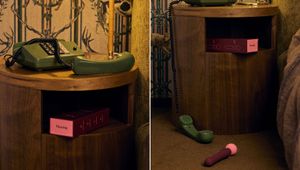
Here’s How Polish Creativity Is Fighting for Women’s Rights

January 2021 saw a huge backwards step for women’s rights in Poland, as a near-total ban on abortion came into effect. The outrage it provoked among women and allies in the country was forceful and inspirational. The demand for restoring women’s rights has not been limited to only issues around access to abortions, but has become a broader movement challenging the status quo on women’s safety and domestic violence, inequality and gender stereotypes. And now as hundreds of thousands of Ukrainian women seek refuge in the neighbouring country, the struggle continues even more urgently.
Considering this extraordinary context. LBB’s Alex Reeves, asked some Polish creatives how the fight for women’s equality has stimulated creativity among women and allies. Here’s what they said.
Dagmara Witek
Chief creative officer at Publicis Poland
More than a year ago, the Constitutional Court's controversial decision to tighten the already strict anti-abortion law brought Polish women to the streets. Their anger was vented with creativity on banners, cardboard placards and hand-painted T-shirts. The slogans, based on idioms, quotes and pop culture contexts, demanded women's rights and insulted MPs and government officials in sharp, ironic terms. What surprised everyone – the women were no longer polite and neither was their language.
Polish women do not want to let anyone tell them how to live, what to think and what to do. Brands are beginning to understand this and to support women in their resistance. Proof of that? A bold and vocal campaign by Yes – a jewellery company that portrayed different faces of feminism: a woman breastfeeding in a public place, another proudly showing off her scars after a mastectomy, a body-positive influencer walking the city streets in her underwear, a Polish sailor kissing her female partner.
The brand announces that this is just the beginning and introduces its 2022 face – Neo Mosa – a non-binary person.
BNP Paribas continues its crusade for women, recruiting female patrons on behalf of schools as a follow up of its famous "Why are there no women on banknotes?" campaign with ‘The Patrons’.
We also received Polish responses to well-known international initiatives and campaigns. Ikea encouraged women to share tasks with men by introducing their Fifty Fifty Cards. Mattel launched a new Barbie Shero inspired by our Olympic hammer throw champion - Anita Wlodarczyk. It is a part of the Dream Gap Project, which introduces girls to the stories of remarkable women to show them that you can be anything.
The fact that women are willing to fight for their rights and go to the barricades does not mean that the old problems go away – there are still a lot of women suffering from domestic violence, and there are a lot of indifferent people around them. The Centre of Women Rights has waged a moving and brutal campaign to make sure abused women are heard and seen.
We cannot talk about women's empowerment today without noting that just over a week ago, the decision of one man led millions of our neighbours – Ukrainian women – to flee their country with their children, to hide in fear for their lives in bomb shelters, or to take up arms and fight for their country and for the values we share. The new chapter of courageous European women's stories is being written before our eyes, there are a lot of our creative colleagues among them, the rest of the creative world should and will stand up for them.
Mikolaj Stefanski and Adam Caban
Associate creative directors at VMLY&R Poland
On 22 October 2020, the Constitutional Tribunal in Poland published a judgment that changed the political compromise that had lasted for 30 years, limiting abortion rights to only a few cases. This situation triggered unprecedented resistance and brought people out onto the streets. The entire public has focused on women's rights issues for many weeks. Before we mention the remarkable creative work done by brands, it is worth noting that creatives have had a huge impact on the protest's reach by producing meaningful work.
Olga Jasionowska, graphic designer and illustrator, is responsible for designing two signs that became the symbol of the women's rights movement in Poland and are still visible in windows, on cars, and media avatars today.
When women's rights became threatened by the judgment of far-right conservatives, many brands had to decide to take a stand. One of the most notable pieces of work came from our VMLY&R Poland office for BNP Paribas. The project was called ‘Schools for Equality’ and addressed one of the sources of inequality for women in Poland – the education system and the lack of female role models promoted in schools.
Women's rights in Poland are violated at various levels, and one of the most tragic and shocking is the lack of adequate understanding of domestic violence and the poor treatment of victims by law enforcement agencies. The Women's Rights Centre, together with the Dziadek do Orzechow agency, has created a powerful short film ‘Womenslaying’, which shows in drastic detail the consequences of leniency towards domestic violence.
Agnieszka Gozdek
Strategy director and partner at 180heartbeats + Jung v Matt
Firstly the nationwide protests - on top of great deal of anger - channelled an enormous amount of spontaneous creativity and were a spectacular and intelligent display of accurate, insightful and scathing social commentary. Quite often both brutal and funny at the same time. So called ‘kartony’ or cardboards carried much better headlines and slogans than those from the media.

Slogans: ‘secular vagina is our holy right’ and ‘government is so nimble it slides into our private parts’
During the past year there has also been an increased discussion about the use of femine versions of female roles and occupations. While she-nurse, or she-cleaner were in use before and were not discussed or encountered much opposition – the newly popular she-surgeon or she-director grew in popularity but encountered opposition and anger from right-wing part of society and politicians as supposedly ‘weird sounding’, despite being in use already several decades earlier. The communication and creative industry, as quite progressive readily embraced ‘dyrektorka’ and ‘copywriterka’. It is the new norm in the industry and visible on LinkedIn.
Among interesting initiatives was a large industry research with the name #PoStronieKobiet (on the side of women) aimed at gathering information on women's’ position in the industry. Also female industry support groups in social media gained support - promoting mentorship and employment opportunities.
There were several notable campaigns. One of them from our agency for the jewellery brand YES, a campaign that broke the mould of how women are portrayed in mainstream campaigns, especially by glamour industry. It received quite spectacular reactions from Polish women, so it was visible that this way of showing Polish women resonated.
The BNP Paribas campaign ‘Where are our female patrons’ brought attention to the fact that female patrons are still conspicuously missing from Polish schools and thus perpetuating inequality in education and socialisation of girls and boys.















